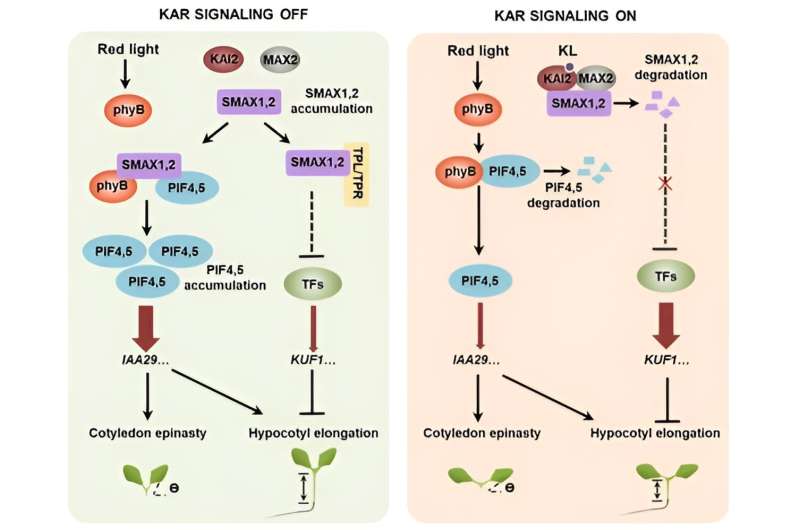This article has been reviewed according to Science X's editorial process and policies. Editors have highlighted the following attributes while ensuring the content's credibility:
fact-checked
peer-reviewed publication
trusted source
proofread
Scientists discover non-transcriptional mechanism of karrikin signaling transduction

Researchers led by Dr. Wang Lei and Wang Bing from the Institute of Genetics and Developmental Biology of the Chinese Academy of Sciences have shown that the non-transcriptional activity of the transcriptional repressor proteins SUPPRESSOR OF MAX2 1 (SMAX1) and SMAX1-like2 (SMXL2) mediates the karrikin (KAR) signaling and red light response in Arabidopsis.
The study was published in Molecular Plant on May 27.
KARs, a class of butenolide molecules, are found in smoke and trigger seed germination mainly in fire followers, the plant species that emerge rapidly after wildfires. KARs also regulate many aspects of plant development and environmental responses, including hypocotyl elongation, leaf shape, root development, symbiosis with arbuscular mycorrhizal fungi, and resistance to drought, salt, and heat stress.
SMAX1 and SMXL2 function as repressor proteins in the KAR signaling pathway; however, the mechanism by which SMAX1 and SMXL2 regulate KAR signaling is still largely unknown.
In this study, the researchers systematically identified proteins that interact with SMAX1 and SMXL2 using mass spectrometry analysis. PHYTOCHROME INTERACTION FACTOR 4 (PIF4) and PIF5 directly interact with SMAX1 and SMXL2 in plants and positively regulate KAR signaling, suggesting that PIF4 and PIF5 are novel components involved in the KAR signaling pathway.
Importantly, SMAX1 and SMXL2 exhibit transcriptional repression activity in an ethylene-response factor-associated amphiphilic repression (EAR) motif-dependent manner; however, they are unable to repress the transcriptional activity of PIF4 and PIF5. Biochemical analysis revealed that SMAX1 and SMXL2 interact with phytochrome B (phyB) and inhibit the interactions of phyB with PIF4 and PIF5, resulting in the accumulation of PIF4 and PIF5 proteins.
More interestingly, about one third of the differentially expressed genes (964 genes) in the smax1 smxl2 double mutant showed comparable expression levels in pSMAX1:SMAX1ΔEAR-GFP/smax1 smxl2 and the wild type, indicating that the non-transcriptional regulatory activity of SMAX1, which is independent of its EAR motif, has a global effect on gene expression.
Furthermore, the non-transcriptional regulatory activity of SMAX1 regulates the expression of genes downregulated in smax1 smxl2 in a PIF4- and PIF5-dependent manner. Among these genes, IAA29 is a direct target of PIF4 and PIF5 and plays an important role in red light responses.
The KAR analog GR24ent-5DS repressed the expression of IAA29 in a PIF4- and PIF5-dependent manner while GR24ent-5DS induced the expression of KARRIKIN UPREGULATED F-BOX 1 (KUF1), which is unrelated to PIF4- and PIF5, in a PIF4- and PIF5-independent manner.
Transcriptional activity assays revealed that SMAX1 enhances the transcriptional activity of the IAA29 promoter in a PIF4- and PIF5-dependent but EAR motif-independent manner, while SMAX1 enhances the transcriptional activity of the KUF1 promoter in a PIF4- and PIF5-independent but EAR motif-dependent manner. Genetic analysis further showed that the overexpression of IAA29 partially restored the phenotype of hypocotyl elongation and cotyledon epinasty in smax1smxl2, indicating that IAA29 is located downstream of SMAX1 and SMXL2.
Taken together, these results suggest that SMAX1 mediates KAR signaling by protecting PIF4 and PIF5 from degradation or by direct transcriptional regulation of downstream genes. The discovery of the dual functions of SMAX1 elucidates the molecular mechanisms underlying how KAR signaling regulates downstream gene expression, particularly in response to red light in Arabidopsis.
More information: Wenwen Chang et al, Non-transcriptional regulatory activity of SMAX1 and SMXL2 mediates karrikin-regulated seedling response to red light in Arabidopsis, Molecular Plant (2024). DOI: 10.1016/j.molp.2024.05.007
Journal information: Molecular Plant
Provided by Chinese Academy of Sciences




















